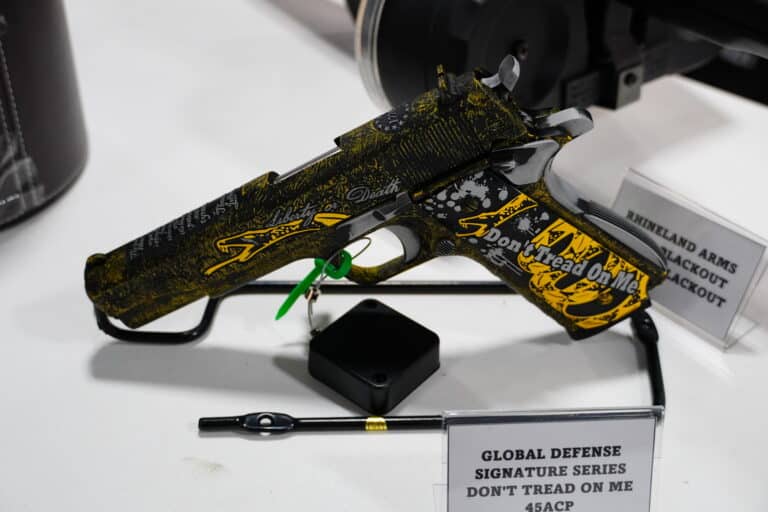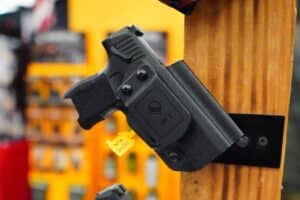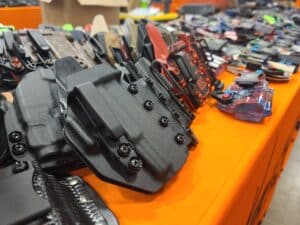California keeps having trouble taking guns away from the kind of people most Americans agree shouldn’t have them, even though it has a database full of their information. That says a lot about how unworkable mass confiscation would actually be in real life.
The Golden State crosschecks everyone in the state who has recently become prohibited from owning guns against its gun registry. It’s called the Armed and Prohibited Persons System (APPS), and the California Department of Justice (DOJ) released a report on its performance this week. It bragged that it removed more people from the list than were added to it in 2023.
“In 2023, DOJ removed 9,051 people from the APPS database of armed and prohibited persons,” the report said. “At the same time, 8,633 people were added to the APPS database of armed and prohibited persons.”
The system has been running since 2006, and this is just the fourth time it has removed more suspected prohibited possessors from the list than it added. The DOJ also reported making more contacts during its investigations than ever before. But it only reduced the number of suspected prohibited possessors by 1.75 percent.
Additionally, 23,451 people remain on the APPS list. It would take decades to clear the backlog at the rate California is moving.
And that’s not to mention the fact that California didn’t actually confiscate guns from the vast majority of the people it removed from the list last year. The state ended up confiscating fewer than 1,500 guns in total through 2023.
This is, again, a confiscation program operating under an ideal set of circumstances. The people California is trying to take guns from are those who’ve been convicted of felonies, domestic violence misdemeanors, been subject to restraining orders, or been adjudicated dangerously mentally ill. While some controversy exists over each of those prohibiting categories, especially for non-violent felons, there is broad support among the American public for disarming people with those kinds of records–and there has been for decades.
Then, of course, California has a registry of every gun sold in the state and who bought it. That’s why we know the pool of people DOJ is looking for is quite small compared to the overall number of Golden State gun owners. In fact, the report found people on the APPS list make up fewer than 0.7 percent of all registered gun owners in the state.
But, despite operating for nearly two decades, 2023’s result of essentially treading water is among the program’s best performances.
The task of confiscating guns would inevitably get progressively more difficult the further away from people who’ve been shown, through a competent judicial process, that they are a danger to themselves or others. As public support for taking guns from different groups of people declines, it will get harder to accomplish. The difficulty of that endeavor will increase exponentially as the number of people and guns that need to be accounted for rises, too.
The DOJ report found that in California alone, through just 2023, 144,242 people bought a gun for the first time.
Considering it took about 50 California law enforcement agents to round up about 1,400 guns in 2023, you’d need 5,000 agents to seize that many. But that’s only for the newest gun owners in the state and only if they own a single firearm. The DOJ report said there are 3,491,463 total registered gun owners across California.
You’d need somewhere around 115,000 officers just dedicated to confiscation to round up guns from them. A force that size would be significantly larger than California’s current population of sworn officers, according to the Public Policy Institute of California.
And that’s just California, which has the strictest gun laws in the nation and a gun ownership rate that’s likely below the national average.
Of course, we don’t know that last part for sure due to another factor that would make any sort of mass confiscation effort even more impractical. Unlike California, most states don’t have a gun registry, and the federal government is barred by law from keeping one. Nobody really knows for sure how many guns Americans writ large own or what the gun ownership rate actually is.
There are estimates, of course. None of them make the prospect of gun confiscation any more workable, though.
Polling varies, but somewhere between 40 and 50 percent of Americans report having a gun in their home. Last November, NBC News found 52 percent of American voters admitted having one. That suggests somewhere between 100 and 130 million Americans live in a home with a gun.
Estimates on the number of guns Americans own are harder to come by but no less monumental. The Small Arms Survey, part of the Geneva Graduate Institute, estimated American civilians own just under 400 million firearms. For context, they estimated American law enforcement has about a million, the American military has about 4.5 million, and all the world’s militaries combined have about 133 million.
And that was back in 2018, two years before the American public went on a record gun-buying streak.
The Trace, a publication that shares a president with the gun-control group Everytown for Gun Safety, put the high-end estimate for civilian firearms in the US at nearly 500 million as of 2023. The number could be even higher today, considering industry estimates have pegged the number of new gun sales each month at over a million for going on several years now.
Whatever the true number is, there’s no realistic chance you could hire enough police officers to round up all of those guns by force–even if they were operating under the best-case scenario that APPS is. That California can’t round up the guns of people most Americans support taking them away from under the best circumstances just goes to show how much of a fantasy any mass confiscation plan would be.
UPDATE 3-17-2024 9:22 AM EASTERN: This piece has been corrected to fix a typo on the estimated number of civilian-owned guns and the math on scaling up California’s confiscation program. The Small Arms Survey estimates there 400 million, not 400 thousand.






